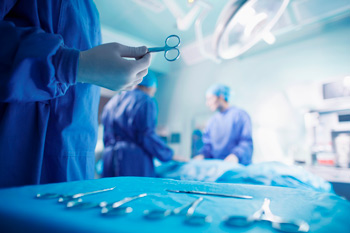MD Anderson created a Continuous Quality Improvement Team to ensure safety with new devices and procedures
 Neither surgeons – nor their patients – can afford a long learning curve when it comes to implementing new medical technologies. The University of Texas MD Anderson Cancer Center is doing everything it can to shorten that learning curve even before new technology is acquired or new procedures are performed – and even before review by value analysis.
Neither surgeons – nor their patients – can afford a long learning curve when it comes to implementing new medical technologies. The University of Texas MD Anderson Cancer Center is doing everything it can to shorten that learning curve even before new technology is acquired or new procedures are performed – and even before review by value analysis.
In 2016, surgical oncologist Thomas Aloia, M.D., created MD Anderson’s Continuous Quality Improvement Team, or CQIT, to ensure safety associated with introducing new devices and technologies into practice, explains Elizabeth Ninian, director of perioperative services.
Prior to that time, the health system’s value analysis team – comprised of surgeons, managers and perioperative materials management – was solely responsible for both the safety and business review of new technologies. In 2016, the CQIT was inserted before the value analysis team, and its mission was/is to conduct a separate safety review.
Makeup
The CQIT is composed of surgical quality officers and perioperative nurses, explains Ninian. (Ninian is no stranger to supply chain, having helped establish the PERT, or peri-op expense reduction team committee, which focuses on product review and impact. This subgroup reports to VAT chairs. )
As Aloia and colleagues explained in the Annals of Surgery earlier this year, all CQIT members were dually trained in surgery or surgical nursing and health safety/quality. The charge of the CQIT is to separate the safety review from the business review and to provide recommendations to the proposing surgeon or groups of surgeons, as well as to the value analysis team (VAT), regarding safety and oversight. To do so, the team uses a structured questionnaire and a corresponding decision algorithm. Based on their findings, the CQIT either recommends against bringing in the technology, or forwarding it for clinical evaluation by the value analysis team (with potential review by the Institutional Review Board and/or the health system’s Quality Improvement Assessment Board).
Evaluation time and complications decrease
MD Anderson has found that total evaluation time for new surgical technologies has decreased since implementation of the CQIT, as have device-related complications.
In a study whose results were reported in the Annals of Surgery, MD Anderson compared the safety and efficiency of a pre-CQIT dataset of 34 product requests evaluated and approved by the VAT alone from May 2015 to November 2016, with 46 product requests evaluated and approved by the VAT after CQIT assessment from October 2016 to August 2017. They found that total mean evaluation time decreased from 124 to 51 days. For new devices requiring intraoperative trial, the time between product proposal and trial decreased from a mean of 260 to 99 days.
Safety improved too. The rate of device-related complications in the pre-CQIT group was 10% compared with 0% post-CQIT. Two devices, which administratively bypassed CQIT review, had both minor and major complications, including a mortality.
During the study, the team not only evaluated new products and devices (e.g., instruments, implants, suture), but novel procedures in a number of specialties, including interventional radiology, thoracic surgery, neurosurgery and plastic surgery. Five procedures approved by CQIT with simulation were performed without complications.
“The CQIT offers an opportunity for the involved stakeholders to ensure proper individuals are engaged, from clinical staff, ancillary support, lab/radiology and IT, and that proper outcomes measures that span many aspects of value – cost, length of stay, outcomes – are considered to help demonstrate the impact of the new device/practice or supply,” says Ninian. “Any new group would benefit from a robust [CQIT] that includes faculty, anesthesia, nursing, finance, materials, sourcing, revenue and procurement.”
Creating a checklist for dry runs of every product, technology or innovative process was “incredibly helpful,” she says. “Also key to our process journey was the recent implementation of a survey after product trial or pilot.
“But for me the most impactful process has been the post-implementation metric review process, where every new product is reviewed for its value impact.”
Discovery questions
The MD Anderson Continuous Quality Improvement Team (CQIT) devised the following questionnaire on which to build a decision algorithm for new technologies or procedures.
-
- What is the rationale for implementing the innovative technique/ procedure/device?
- Has this procedure been done/device been used before in humans outside of our institution?
- If so, what are the short-term safety/complications data from those treatments?
- Are there any long-term functional/complications data available?
- Has the procedure been done/device been used at our institution in a different setting?
- If yes, is internal safety data available?
- If no, is there a center that could be visited to gain expertise on the technique/procedure/device?
- Are there references in the literature describing the technique and outcomes? List references and summarize results.
- Are there particular anesthesia/nursing/OR/postoperative issues (preparation, training, cleaning, ancillary equipment, patient follow-up) that are new to our institution related to use of the technique/device?
- Do the surgeons involved (submitting surgeon and/or their surgical group) have a financial disclosure related to the technique/procedure/device?
